Putting gym equipment on the second floor of your house or in an apartment might worry you a little because that stuff is heavy. Those are valid concerns and in this article, we’ll outline what is and isn’t possible in an apartment or upstairs.
Placing a power rack upstairs in an apartment is possible but the weight should be limited to about 400 pounds. There are some noise and safety considerations you should take seriously. Equipment choice, flooring protection, and avoiding large impacts are crucial.
In the rest of this article, we’ll go into the details of what your floor can handle, what the limits are, and how you can keep your neighbors happy.
Also, check out this post for more background information: Can you build a home gym in an apartment?
Contents
- 1 Can You Put a Power Rack In an Apartment?
- 2 Noise and vibrations
- 3 Damage
- 4 How Heavy Can You Lift In an Apartment?
- 5 Can You Drop Weights In an Apartment or Upstairs?
- 6 How To Keep Your Neighbors Happy When Lifting In an Apartment
- 7 Best Power Racks For Upstairs and Apartments
- 8 How to Make Lifts Heavier In an Apartment
- 9 FAQ
Can You Put a Power Rack In an Apartment?
Building a home gym upstairs doesn’t have to include a power rack but many people would like it. Can you make it work? In most cases an apartment squat rack is possible but you have to take a few things into account.
It is possible to use a power/squat rack in an apartment but there are some noise and safety considerations you should take seriously.
Considerations
The floor actually holding the weight is the most important part of apartment squat racks. Before we get into the details, I’m assuming the following points;
With that out of the way, let’s take a look at the details of having a squat rack on a second floor or higher.
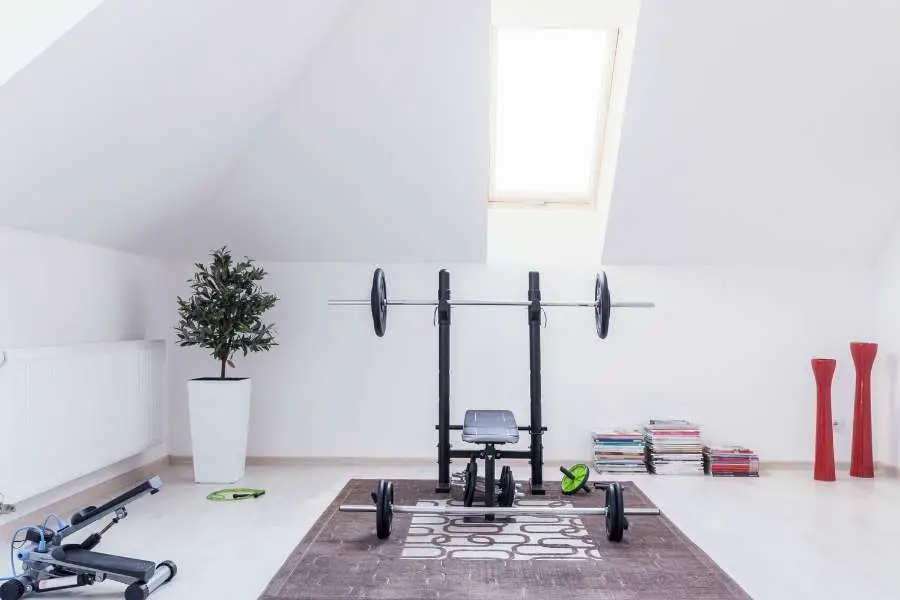
Understanding Floor Weight Limits
Any floor, regardless of where it is, has a limit to the amount of weight it can support before issues arise. The thought of a collapsing floor is far from ideal, so how much weight can an apartment floor actually hold?
Check out this chart from building report that outlines apartment floor weight limits.

As illustrated, for bedrooms, there are two important values to consider: the minimum load limit for the entire room (30 pounds per square foot) and the concentrated load limit (300 pounds).
“Live load” encompasses everything not attached to the house, such as furniture, books, appliances, and, of course, exercise equipment – including your gym setup.
To put this into practical perspective, let’s calculate how much weight an average room can handle. You’re likely to transform your spare bedroom into a home gym, and the average bedroom size in the United States is approximately 132 square feet.
That’s a substantial weight capacity for most humans. However, it’s essential to distribute the weight evenly and avoid placing more than 300 pounds in any one spot to ensure the structural integrity of your apartment’s floor.
That last point is worth repeating: The maximum live load in one spot is 300 pounds.
What Does That Mean For You?
Let’s look at a popular home gym rack like the Fitness Reality 810XLT (Amazon).
That leaves 342 lbs. for weights to be loaded on the rack. And that’s all the weights, including the plates on the storage pegs, barbell, etc. Sure there are safety margins in building codes but do you really want to test them?
So placing an apartment squat rack and weights is perfectly possible as long as you keep the weights somewhat limited. However, this is just for static loads. For actual lifting, the considerations are a little different, keep reading below to find out more.
Suggested post: Can you safely put a treadmill upstairs?
Noise and vibrations
That something is technically possible doesn’t mean it’s a good idea. While building a home gym upstairs with barbells, weight plates, and a power rack isn’t going to cause problems in and of itself, you lifting certainly might.
Weightlifting can cause serious noise and vibrations that disturb the neighbors. There are some ways to reduce this but it’s hard to completely eliminate all the noise and vibrations that come from weightlifting.
Below we’ll share some tips you can use to minimize these problems but use your own judgement as well.
Damage
Be aware that you can do some serious damage to the flooring and even the structural integrity of a building if you’re careless and exceed load limits. This is nothing to take lightly because the results can be absolutely disastrous.
It is possible to damage your floor and even structural integrity if you lift weights that are too heavy and don’t take precautions in an apartment home gym.
Also, you can damage the flooring surface of your apartment quite easily if you don’t take the right precautions. If it’s your own apartment, go ahead but if it’s a rental, this can cost you your deposit and more.
How Heavy Can You Lift In an Apartment?
I’d be more concerned about the actual lifting itself than the rack. The weight of a rack is spread out over a larger surface area, while during a lift, all that weight is concentrated right beneath your feet.
500 pounds is the absolute limit of how much you should lift in an apartment. Sticking to 400 pounds leaves some room for error.
The two lifts where people put the most weight on the bar are squats and deadlifts. In both of these movements, your feet are relatively close together, meaning the entire load is focused on a small area – the floor beneath you.
This is a crucial consideration for serious lifters, especially when you realize that the concentrated load limit is typically around 300 pounds. If your feet are wide enough apart, that means a theoretical limit of 600 pounds.
And when you lower the deadlift, the weight rests on the two small spots where the weight plates touch the floor.
Also, keep in mind that 300-pound load limit is a static load, not dynamic i.e. moving. A moving 300-pound weight puts considerably more load on the floor than a static one. That’s why it’s advisable to stay well under the 600-pound total weight lifted in an apartment or upstairs.
About 400 pounds is a good limit to set for yourself, maybe 500 if you can set the weight down in a very controlled manner.
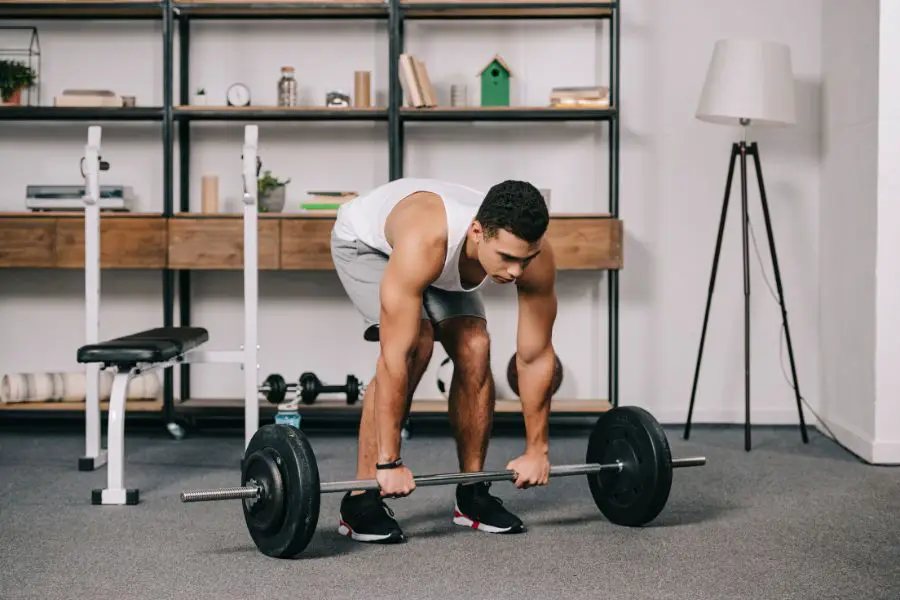
Spread the load
Spreading out the load is a great way to reduce the spot pressure on the floor. Building a weightlifting platform by placing wooden boards on the floor and then thick rubber mats on top is a viable way to do this.
Make sure at least the whole area where you stand and where the plates hit the floor are covered. Thicker boards and rubber are going to be better.
You can also invest in a deadlift platform. A deadlift platform typically consists of a sturdy metal or wooden frame with rubber mats laid on top. By doing this, you can effectively spread the weight over a significantly larger surface area.
For example, the Rogue Fitness deadlift platform measures an ample 8′ x 4′, which means it can disperse the weight over a large area.
Close to The Wall
Place the heaviest loads as close to load-bearing walls as possible. The floor is stronger there than in the middle. I’d still not go over any load limits set in the building code but it will be a bit stronger there. The floor will also flex less near a load-bearing wall which means less noise and vibrations.
Can You Drop Weights In an Apartment or Upstairs?

In the previous section, we discussed which weights are safe to lift in an apartment home gym, but we didn’t take into account the potential for dropping weights. It’s worth noting that many people, especially during deadlifts or occasionally by accident, might find themselves dropping weights.
If you’ve reached a point in your lifting journey where you’re pushing the weight limits of your apartment floor, it’s crucial to reconsider the idea of dropping weights. As anyone with a basic understanding of physics knows, a moving object carries much more energy than a stationary one.
Consequently, a barbell with a significant weight on it, falling to the floor, has the potential to cause damage to your floor or even the underlying structure even if it’s well below the static weight limit of the floor. It’s prudent to err on the side of caution in this regard.
Dropping the weight on purpose and repeatedly is a terrible idea in an apartment. Not only is it potentially damaging to the floor and structure, but it will also upset everyone living in the same building.
That noise and those vibrations won’t only be heard and felt by your direct neighbors but the whole building.
While using deadlift crash pads (available on Amazon, for example) can significantly help dissipate the impact energy, they don’t offer an absolute guarantee. Nonetheless, crash pads serve other valuable purposes, such as reducing noise and safeguarding your floors. That’s why they’re a good idea to get anyway.
To delve deeper into the topic of gym flooring and explore your options, you can find more information in our dedicated post on gym flooring (CLICK).
How To Keep Your Neighbors Happy When Lifting In an Apartment
Living in an apartment means you’re in close quarters with neighbors, and your weightlifting endeavors are likely to disturb them. The main culprits are the noise and vibrations lifting in an apartment or upstairs create. If you want to have a workout room in a second-story apartment (or higher) here’s what you have to know.
The main ways this happens are;
Here are some practical steps to minimize these disturbances and minimize the noises and vibrations coming from your apartment home gym.
1. Equipment Choice
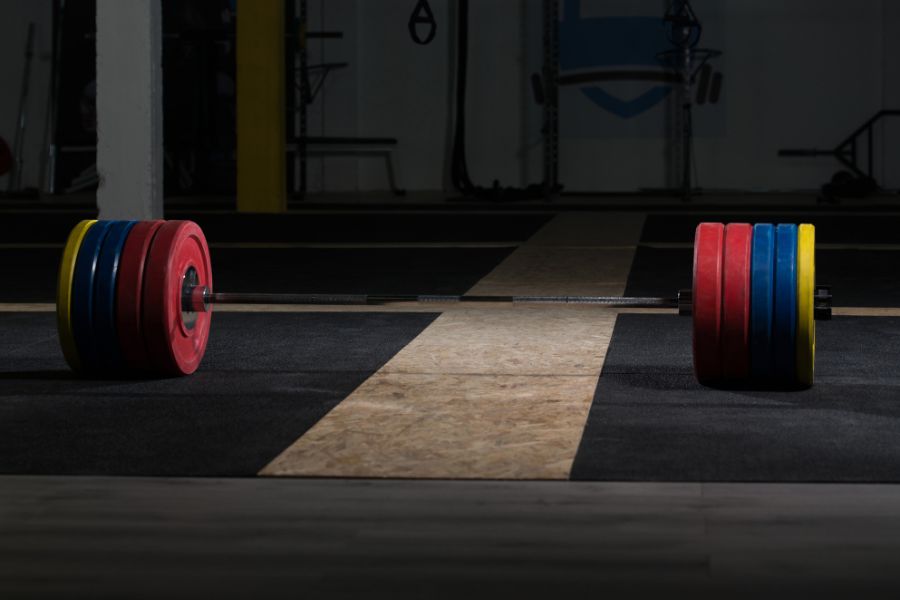
Your equipment choices can make an impact on how much noise and vibrations are transmitted.
Many large power racks have to be bolted to the floor for optimal safety and stability. That’s a bad idea in an apartment anyway, especially if it’s a rental. But because of noise and vibration concerns, this is an extra special bad idea.
Bolting the rack to the floor creates a solid connection between the rack and the floor. That means everything that impacts the rack, also directly impacts the floor.
Having a non-bolted rack with rubber underneath is going to reduce the transmitted vibrations quite a bit. Combine this with some rubber on the J-cups and it’s a massive difference. Picking a rack with bigger feet is better too since this spreads out the load more.
The other important equipment choice is the weight plates. This is one time I’d recommend getting bumper plates even if you won’t drop the weights. Bumper plates are made from rubber which means a less sharp impact. They’re also wider which means the load is spread out over a larger area. Rubber-coated steel plates are a close second.
2. Use Gym Flooring
The use of thick rubber gym flooring shouldn’t even be a question. That’s the bare minimum you should do. Gym flooring protects your floor but also reduces any impact noises and vibrations. It has some other neat benefits on top of that.
You can consider wooden/particle boards underneath the rubber to spread out the load and impact even more. You can read here how to pick the right gym flooring.
And no, carpet is not a great gym flooring for under your squat rack.
3. Use Crash Pads
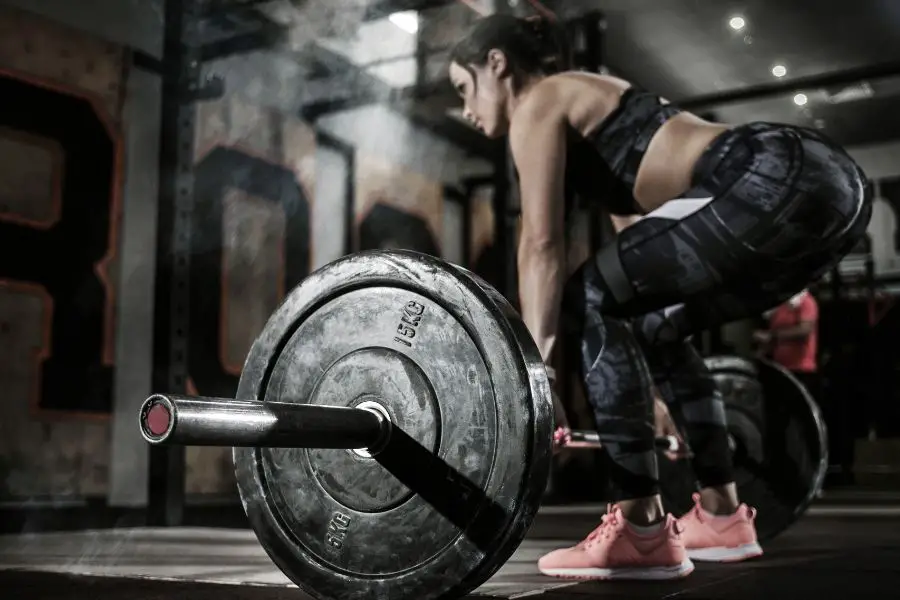
For deadlifts and other lifts that start/end on the floor, deadlift crash pads are a great idea. They are basically airbags for your weights and make the impact a lot softer.
Especially when deadlifting in an apartment, these things can be a lifesaver. (Because your neighbors might not want to kill you anymore.) Deadlifts are usually done very heavy and most people let them impact the floor at a considerable speed even when trying to set the bar down slowly.
Deadlifting upstairs is probably the biggest reason for loud banging noises and vibrations so if you like doing them, these are a must-have.
4. Limit The Weight
The heavier the weight, the louder even a gentle touch will sound. Limiting the weights is a key way to increase safety and reduce noise. Even though you might not like doing so, it’s something you might have to do to be able to keep lifting in an apartment home gym.
5. Avoid Dropping the Bar:
Do your best to place the bar down on the rack or floor gently. A smooth lift doesn’t make any noise unless it’s coming from your mouth. Placing the bar down on the rack or floor is what makes the most noise.
All the gym flooring and crash pads in the world can’t help prevent noises if you throw the weights around like a gorilla.
6. Quiet Reracking
Place weights back on racks as quietly as possible. You can even consider adding rubber coverings to the rack’s pins and J-cups for extra noise reduction.
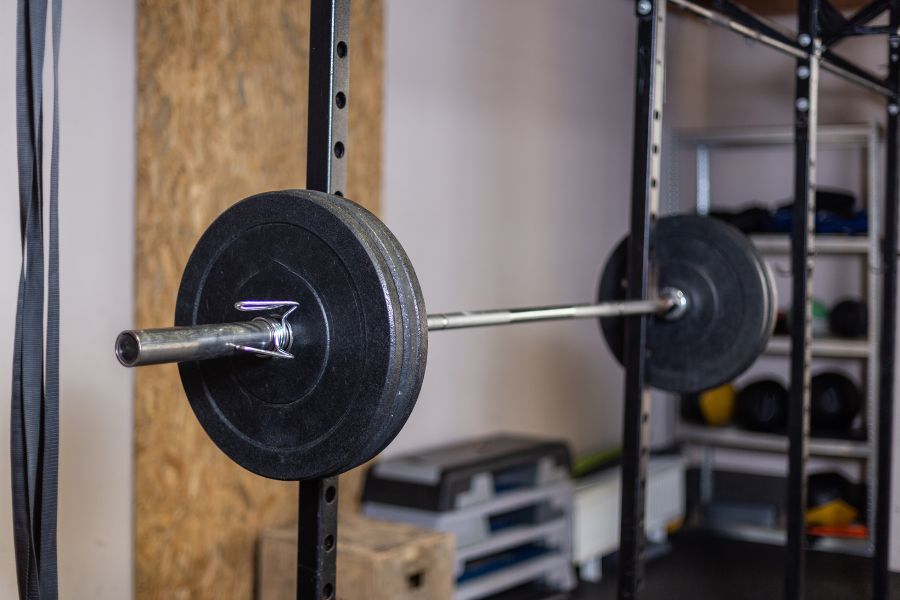
7. Load/Unload Gently
Loading plates on the bar can mean banging them against each other. Avoid that as much as possible.
The same goes for unloading the bar. Don’t throw the plates on the floor, lower them carefully or place them on a storage peg. Choosing rubber-coated or bumper plates will be a lot quieter than bare metal plates.
8. Grunting Consideration
Unfortunately, your neighbors might have to endure your motivational grunting during intense sets. Heavy breathing is fine, screams and grunts should be completely avoided. That’s a good way to get the cops called on you.
9. Initiate a Neighborly Conversation
Keep in mind, the people living downstairs aren’t only disturbed by the noises, they are worried you’re going to crash down through the ceiling. If I knew you were lifting very heavy weights above my head without taking any precautions, I would be very quick to make a call to the HOA or other relevant authority. That’s not because I don’t like you lifting, It’s because I’m worried about my own safety.
Neglecting to talk with your neighbors might lead to some disgruntled residents ready to rally with torches and pitchforks. And it’s much better to have this talk proactively than after your neighbors are already upset.
Best Power Racks For Upstairs and Apartments
The best power and squat racks for an apartment or upstairs should be;
Here are your best options:
Fitness Reality 810XLT
CAP FM8000F
How to Make Lifts Heavier In an Apartment
So, you can lift in an apartment or upstairs but you’re relatively limited in weight. So what can you do to make your workouts more challenging?
If you’re just training for strength, it’s hard to replace the raw weight. The tips below will be mostly useful for hypertrophy but it’ll help strength if you’re not an elite lifter yet as well.
By following these tips, you won’t need to lift more than 500 pounds. Try to use all the tips in one workout and see how you feel the next day, you’ll probably be quite sore.
FAQ
Can I safely put a treadmill on the second floor?
Yes, if your floor is up to code a normal treadmill is no problem. Home gym treadmills weigh up to 300 pounds and have 300 lbs load limit on top of that. A heavy treadmill will have a big footprint to distribute that weight over enough floor surface to be safe.
Can I safely stack my weights on the second floor?
In any house or apartment that’s up to code, it’s safe to stack up to 300 lbs. in one spot. More than that is not advisable. If you have more weight plates, spread them out over a larger area without exceeding the limit of 30 pounds per sq. ft. for the whole room.

